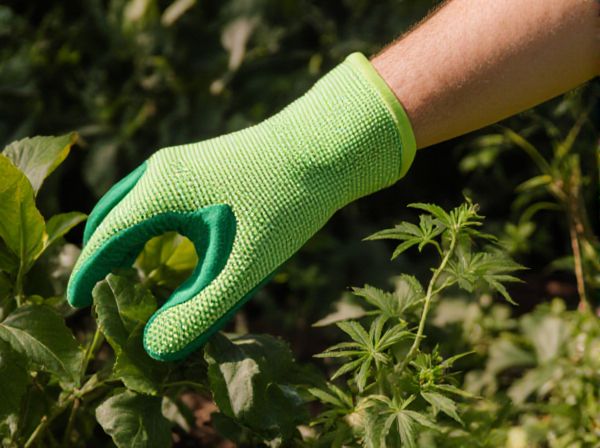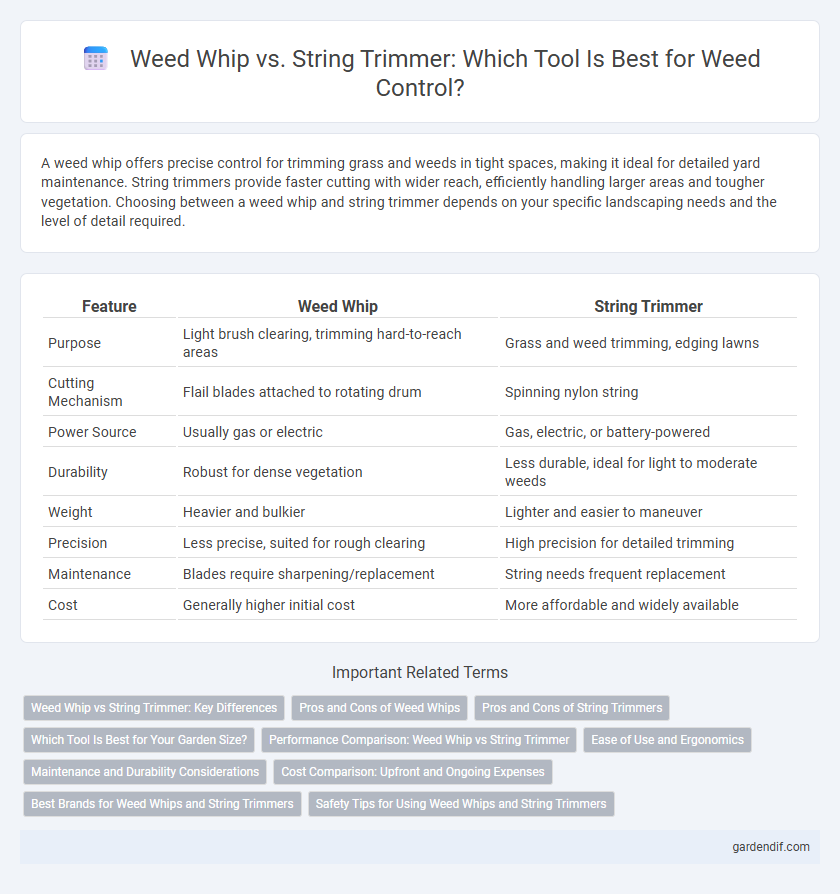
Weed whip vs string trimmer Illustration
A weed whip offers precise control for trimming grass and weeds in tight spaces, making it ideal for detailed yard maintenance. String trimmers provide faster cutting with wider reach, efficiently handling larger areas and tougher vegetation. Choosing between a weed whip and string trimmer depends on your specific landscaping needs and the level of detail required.
Table of Comparison
| Feature | Weed Whip | String Trimmer |
|---|---|---|
| Purpose | Light brush clearing, trimming hard-to-reach areas | Grass and weed trimming, edging lawns |
| Cutting Mechanism | Flail blades attached to rotating drum | Spinning nylon string |
| Power Source | Usually gas or electric | Gas, electric, or battery-powered |
| Durability | Robust for dense vegetation | Less durable, ideal for light to moderate weeds |
| Weight | Heavier and bulkier | Lighter and easier to maneuver |
| Precision | Less precise, suited for rough clearing | High precision for detailed trimming |
| Maintenance | Blades require sharpening/replacement | String needs frequent replacement |
| Cost | Generally higher initial cost | More affordable and widely available |
Weed Whip vs String Trimmer: Key Differences
Weed whips and string trimmers differ primarily in design and application, with weed whips featuring a flexible shaft and a cutting blade ideal for edging and precise trimming, while string trimmers use a spinning nylon line to rapidly clear larger grassy areas. String trimmers typically offer more power and efficiency for extensive lawn maintenance, whereas weed whips provide better control in tight spaces and delicate garden beds. Choosing between them depends on yard size, vegetation type, and the need for precision versus speed.
Pros and Cons of Weed Whips
Weed whips offer precision trimming ideal for delicate garden areas and edging along flowerbeds, providing greater control than string trimmers. They are typically lighter and quieter, reducing user fatigue and noise pollution, but their limited reach and slower cutting speed can hinder efficiency in larger yards. Weed whips often require more frequent replacement of trimming lines compared to the more durable and powerful string trimmers.
Pros and Cons of String Trimmers
String trimmers offer precise edging and versatile weed cutting ideal for garden maintenance, excelling in maneuverability around tight spaces and delicate plants. Their lightweight design reduces user fatigue during extended use, while adjustable shaft lengths and rotating heads enhance comfort and accessibility for different tasks. However, string trimmers require regular string replacement and may struggle with dense, woody stems compared to more robust alternatives like weed whips.
Which Tool Is Best for Your Garden Size?
For small to medium-sized gardens, a weed whip offers precise control and ease of use, making it ideal for trimming around flower beds and fences. Larger gardens with expansive, tough weed growth benefit more from a string trimmer, which delivers greater power and cutting width for faster cleanup. Garden size and vegetation density are key factors in choosing between a lightweight weed whip and the robust performance of a string trimmer.
Performance Comparison: Weed Whip vs String Trimmer
Weed whips offer precision and agility for trimming around delicate plants and garden edges, making them ideal for detailed landscaping tasks. String trimmers provide more power and coverage, efficiently tackling larger areas with thick grass and tougher weeds due to their robust motor and wider cutting swath. Choosing between a weed whip and string trimmer depends on the scale and nature of the yard maintenance, with string trimmers excelling in heavy-duty performance and weed whips delivering finer control.
Ease of Use and Ergonomics
Weed whips offer lightweight design and simple operation, making them easy to maneuver for extended periods without causing significant fatigue. String trimmers often feature adjustable handles and variable speeds, enhancing control and comfort for diverse user preferences. Ergonomic considerations in both tools prioritize reducing strain, but weed whips typically excel in portability and straightforward usability.
Maintenance and Durability Considerations
Weed whips require minimal maintenance, primarily involving occasional line replacement and simple motor upkeep, making them cost-effective for long-term use. String trimmers often demand more frequent maintenance such as air filter cleaning, spark plug checks, and cutting head adjustments due to their more complex engine systems. Durability of weed whips generally surpasses that of string trimmers in rugged terrains, as their straightforward design reduces mechanical failures and extends operational lifespan.
Cost Comparison: Upfront and Ongoing Expenses
Weed whips typically offer a lower upfront cost, ranging from $30 to $100, compared to string trimmers that can start around $70 and exceed $300 for advanced models. Ongoing expenses for weed whips are minimal, primarily involving occasional replacement of the whip attachment, while string trimmers require regular purchases of replacement strings, fuel, or batteries, which can significantly increase long-term costs. For budget-conscious users, the simpler maintenance and durability of weed whips often result in a more cost-effective solution over time.
Best Brands for Weed Whips and String Trimmers
Top brands for weed whips include Fiskars and DeWalt, known for their durability and ergonomic designs. For string trimmers, Stihl and Husqvarna dominate the market with powerful engines and advanced cutting technology. Both brands emphasize long-lasting performance and user comfort, making them ideal choices for lawn care enthusiasts.
Safety Tips for Using Weed Whips and String Trimmers
Wear protective eyewear, gloves, and long sleeves to prevent injuries from debris or flying grass when using both weed whips and string trimmers. Maintain a firm grip and keep a safe distance from others to avoid accidental contact with the rotating line or whip end. Regularly inspect equipment for damage and ensure the cutting line or whip blades are properly installed to maintain control and reduce the risk of accidents.
Weed whip vs string trimmer Infographic

 gardendif.com
gardendif.com